 W
WThe term woodboring beetle encompasses many species and families of beetles whose larval or adult forms eat and destroy wood. In the woodworking industry, larval stages of some are sometimes referred to as woodworms. The three most speciose families of woodboring beetles are longhorn beetles, bark beetles and weevils, and metallic flat-headed borers.
 W
WAcmaeodera angelica is a species of metallic woodboring beetle in the family Buprestidae. It is found in Central America and North America.
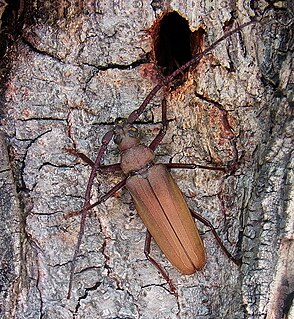 W
WAegosoma scabricorne is a species of long-horned beetles belonging to the family Cerambycidae.
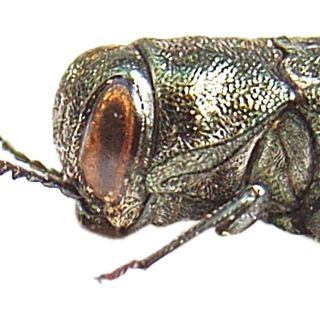 W
WAgrilus is a genus of jewel beetles, notable for having the largest number of species of any single genus in the animal kingdom.
 W
WAgrilus auroguttatus is a species of jewel beetle in the United States, known by the common name goldspotted oak borer. It is a woodboring beetle best known for destroying stands of oak trees in the Cleveland National Forest in San Diego County, California, in the United States. It was originally considered a subspecies of the Central American species Agrilus coxalis, and much of the literature refers to it by this name, but now it is regarded as a separate species, known only from Arizona and California.
 W
WAgrilus hyperici, the St. John's wort root borer, is a species of jewel beetle. It is used as an agent of biological pest control against common St. John's wort in areas where it is a noxious weed or invasive species.
 W
WAgrilus viridis is a wood-boring beetle. It belongs to the jewel beetle family, Buprestidae.
 W
WA bark beetle is one of about 6,000 species in 247 genera of beetles in the subfamily Scolytinae. Previously, this was considered a distinct family (Scolytidae), but is now understood to be specialized clade of the "true weevil" family (Curculionidae). Although the term "bark beetle" refers to the fact that many species feed in the inner bark (phloem) layer of trees, the subfamily also has many species with other lifestyles, including some that bore into wood, feed in fruit and seeds, or tunnel into herbaceous plants. Well-known species are members of the type genus Scolytus, namely the European elm bark beetle S. multistriatus and the large elm bark beetle S. scolytus, which like the American elm bark beetle Hylurgopinus rufipes, transmit Dutch elm disease fungi (Ophiostoma). The mountain pine beetle Dendroctonus ponderosae, southern pine beetle Dendroctonus frontalis, and their near relatives are major pests of conifer forests in North America. A similarly aggressive species in Europe is the spruce ips Ips typographus. A tiny bark beetle, the coffee berry borer, Hypothenemus hampei is a major pest on coffee plantations around the world.
 W
WBelionota sumptuosa, commonly known as the Tricolor Metallic Wood-boring Beetle, is a jewel beetle of the Buprestidae family. It is found in Indonesia.
 W
WThe bronze birch borer Agrilus anxius is a wood-boring Buprestid beetle native to North America, more numerous in warmer parts of the continent and rare in the north. It is a serious pest on birch trees (Betula), frequently killing them. The river birch Betula nigra is the most resistant species, other American birches less so, while the European and Asian birches have no resistance to it at all and are effectively impossible to grow in the eastern United States as a result.
 W
WBuprestidae is a family of beetles known as jewel beetles or metallic wood-boring beetles because of their glossy iridescent colors. Larvae of this family are known as flatheaded borers. The family is among the largest of the beetles, with some 15,500 species known in 775 genera. In addition, almost 100 fossil species have been described.
 W
WChalcophora japonica, or ubatamamushi in Japanese, also known as the flat-headed wood-borer, is a metallic, bullet-shaped, woodboring beetle of the Buprestidae family. It is endemic to Japan.
 W
WThe Sculptured Pine Borer or Chalcophora virginiensis is a metallic woodboring beetle of the Buprestidae family. It is endemic to forested areas in the eastern United States and Canada. Some authors have synonymised it with the western species Chalcophora angulicollis, but Maier and Ivie (2013) demonstrate that the species are distinct.
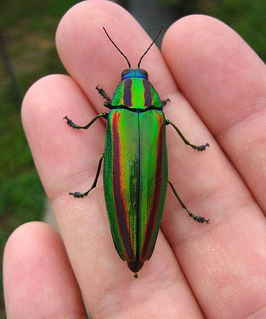 W
WChrysochroa fulgidissima, "jewel beetle" or Yamato tamamushi in Japanese (ヤマトタマムシ) is a metallic woodboring beetle of the family Buprestidae.
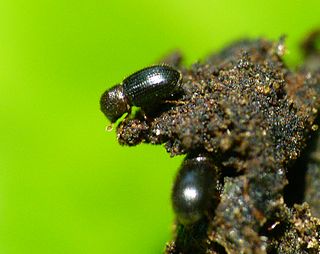 W
WThe coffee borer beetle or coffee berry borer is a small beetle native to Africa. It is among the most harmful pests to coffee crops across the world where coffee is cultivated. Spanish common names of the insect include barrenador del café, gorgojo del café, and broca del café.
 W
WThe common furniture beetle or common house borer is a woodboring beetle. In the larval stage it bores in wood and feeds upon it. Adult Anobium punctatum measure 2.7–4.5 millimetres (0.11–0.18 in) in length. They have brown ellipsoidal bodies with a prothorax resembling a monk's cowl .
 W
WCoptomma marrisi is a species of longhorn beetle only known from Great Island in the Three Kings Islands, New Zealand.
 W
WThe deathwatch beetle is a species of woodboring beetle that sometimes infests the structural timbers of old buildings. The adult beetle is brown and measures on average 7 mm (0.3 in) long. Eggs are laid in dark crevices in old wood inside buildings, trees, and inside tunnels left behind by previous larvae. The larvae bore into the timber, feeding for up to ten years before pupating, and later emerging from the wood as adult beetles. Timber that has been damp and is affected by fungal decay is soft enough for the larvae to chew through. They obtain sufficient nourishment by using a number of enzymes present in their gut to digest the cellulose and hemicellulose in the wood.
 W
WDendroctonus frontalis, the southern pine beetle, is a species of bark beetle native to the forests of southern United States, Mexico and Central America. It has a hard reddish brown to black exoskeleton and measures approximately 3 mm (0.12 in), about the size of a grain of rice. It is short-legged, the front of the males head is notched, the female possesses a wide elevated transverse ridge, and the hind abdomen of both is round.
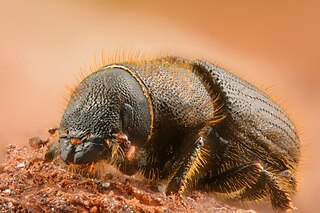 W
WDendroctonus micans, the great spruce bark beetle, is a species of bark beetle native to the coniferous forests of Europe and Asia. The beetles burrow into the bark of spruce trees and lay eggs which develop into larvae that feed on the woody layers under the bark.
 W
WDendroctonus pseudotsugae, the Douglas-fir beetle, is a species of bark beetle found in western North America. Three subspecies exist that correspond to the subspecies of Douglas-fir. The beetles also infest downed Larch trees. Outbreaks often occur in conjunction with drought, root rot diseases, overcrowding, damage by insects that damage foliage, and environmental disturbance. This insect is part of the western forest ecosystem, playing a role in thinning weak trees in a stand.
 W
WDendroctonus rufipennis, the spruce beetle, is a species of bark beetle native to British Columbia, Newfoundland and Labrador, Nova Scotia, Ontario, Quebec, Northern Manitoba, the Yukon, Colorado, Wyoming, Montana, and Maine. They are known to destroy forests of spruce trees including Engelmann, White, Sitka, and Colorado blue spruce. Adults average 4 to 7 mm in length.
 W
WDendroctonus terebrans, the black turpentine beetle, is a species of bark beetle native to the eastern United States. Its larvae tunnel under the bark of pine trees, weakening and sometimes killing the trees.
 W
WDendroctonus valens, the red turpentine beetle, is a species of bark beetle native to the forests of North America, Mexico, Guatemala and Honduras. It has been introduced to China where it has become invasive. In its native range it causes little damage, but in China it is a destructive pest and has killed more than six million pine trees.
 W
WThe emerald ash borer, also known by the acronym EAB, is a green buprestid or jewel beetle native to north-eastern Asia that feeds on ash species. Females lay eggs in bark crevices on ash trees, and larvae feed underneath the bark of ash trees to emerge as adults in one to two years. In its native range, it is typically found at low densities and does not cause significant damage to trees native to the area. Outside its native range, it is an invasive species and is highly destructive to ash trees native to Europe and North America. Prior to being found in North America, very little was known about emerald ash borer in its native range; this has resulted in much of the research on its biology being focused in North America. Local governments in North America are attempting to control it by monitoring its spread, diversifying tree species, insecticides, and biological control.
 W
WEuropean lyctus beetle is a species of beetle in the family Bostrichidae. It is a member of the subfamily Lyctinae, the powderpost beetles. It was originally native to tropical regions, but it can now be found worldwide. It is a common pest of wood and wood products and it is transported around the world with them. It is most common in deciduous tree woods.
 W
WThe European spruce bark beetle, is a species of beetle in the weevil subfamily Scolytinae, the bark beetles, and is found from Europe to Asia Minor and some parts of Africa.
 W
WHylotrupes is a monotypic genus of woodboring beetles in the family Cerambycidae, the longhorn beetles. The sole species, Hylotrupes bajulus, is known by several common names, including house longhorn beetle, old house borer, and European house borer. It is the only genus in the tribe Hylotrupini.
 W
WLampetis dilaticollis is a beetle of the family Buprestidae.
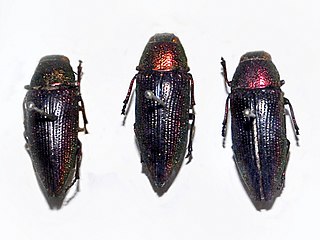 W
WLampetis orientalis is a jewel beetle of the family Buprestidae.
 W
WLasioderma serricorne, commonly known as the cigarette beetle, cigar beetle, or tobacco beetle, is an insect very similar in appearance to the drugstore beetle and the common furniture beetle. All three species belong to the family Ptinidae.
 W
WLyctus carbonarius is a wood-boring beetle in the family Bostrichidae, commonly known as the southern lyctus beetle or lyctid powderpost beetle. It is a serious pest of hardwoods including ash, hickory, oak, maple and mahogany and can infest many products in the home including hardwood flooring and structural timbers, plywood, furniture, tool handles, picture frames, baskets and ladders. Timber can be infested in one location and then be transported large distances by ship, after which the beetles can emerge and spread the infestation to new areas.
 W
WThe Lymexylidae, also known as ship-timber beetles, are a family of wood-boring beetles. Lymexylidae belong to the suborder Polyphaga and are the sole member of the superfamily Lymexyloidea.
 W
WThe mountain pine beetle is a species of bark beetle native to the forests of western North America from Mexico to central British Columbia. It has a hard black exoskeleton, and measures approximately 5 millimetres, about the size of a grain of rice.
 W
WThe patent-leather beetle or horned passalus is a saproxylic beetle in the family Passalidae which can grow to just over an inch-and-a-half long, weigh 1-2 grams and are capable of pulling 50 times their own weight. They have been used to study several aspects of general family characteristics since the early 1900s but remain a relatively unknown species within the diverse Coleoptera order.
 W
WThe lemon tree borer, also known as the whistling beetle or the singing beetle, is a longhorn beetle endemic to New Zealand. Its larvae are generalist feeders, boring into the wood of a wide variety of trees, native and introduced. When citrus orchards were first established in New Zealand, this beetle started inflicting serious damage, and so gained the name "lemon tree borer". Four species within the genus Oemona have been identified, suggesting that more species could be found. When disturbed by predators or humans, the adult beetle stridulates creating a "rasp" or "squeak" sound by rubbing its thorax and head together against an area of thin ridges. Māori would eat a liquid called "pia manuka", which was produced by manuka trees when its wood was damaged by the larva. When Captain Cook first arrived in NZ, his naturalists, Banks and Solander, collected a lemon tree borer in their first collection between 1769-1771. This oldest collected specimen can be found in the British Museum. A few years after the first collection, the species would be first described by the Danish naturalist Fabricius in 1775.
 W
WPhymatodes testaceus is a transpalearctic polymorphic species of beetle in the subfamily Cerambycinae in the longhorn beetle family.
 W
WPlatypus apicalis, known by its common name the New Zealand pinhole boring beetle, is a wood boring beetle endemic to New Zealand and found throughout the North and South Island in a range of environments.
 W
WPowderpost beetles are a group of seventy species of woodboring beetles classified in the insect subfamily Lyctinae. These beetles, along with spider beetles, death watch beetles, common furniture beetles, skin beetles, and others, make up the superfamily Bostrichoidea. While most woodborers have a large prothorax, powderpost beetles do not, making their heads more visible. In addition to this, their antennae have two-jointed clubs. They are considered pests and attack deciduous trees, over time reducing the wood to a powdery dust. The damage caused by longhorn beetles is often confused with that of powderpost beetles, but the two groups are unrelated. The larvae of the Cerambycidae are white, straight and generally flat-headed, whereas those of the Bostrichidae are white and C-shaped.
 W
WThe Prioninae are a subfamily of Cerambycidae. They are typically large (25–70 mm) and usually brown or black. The males of a few genera sport large mandibles that are used in fights with other males, similar to stag beetles. These beetles are commonly nocturnal and are attracted to light. The majority of the Prioninae whose biology is known are borers whose larvae feed on rotting wood or roots.
 W
WPtinidae is a family of beetles in the superfamily Bostrichoidea. There are at least 220 genera and 2,200 described species in Ptinidae worldwide. The family includes spider beetles and deathwatch beetles.
 W
WTemognatha grandis is a species of beetles belonging to the family Buprestidae.
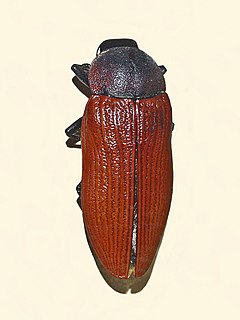 W
WTemognatha heros, the Yellow Jewel Beetle or Large Jewel Beetle, is a species of beetles belonging to the family Buprestidae.
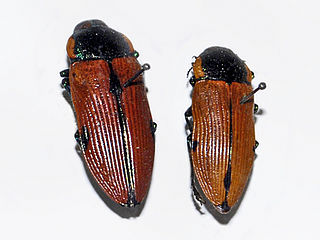 W
WTemognatha alternata, commonly known as the variable jewel beetle, is a beetle of the family Buprestidae.
 W
WThe weaver beetle is a species of beetle from subfamily Lamiinae in long-horned beetle family; it is a North Asia species. Larvae develop in willow trees, rare in birch and poplar.
 W
WA woodworm is the wood-eating larva of many species of beetle. It is also a generic description given to the infestation of a wooden item by these larvae.
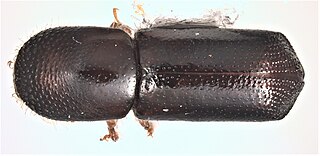 W
WXyleborus glabratus is a type of ambrosia beetle invasive to the United States. It has been documented as the primary vector of Raffaelea lauricola, the fungus that causes laurel wilt, a disease that can kill several North American tree species in the family Lauraceae, including redbay, sassafras, and avocado.
 W
WXylopertha is a genus of beetle found in Europe, the Near East and North Africa.
 W
WZopherus is a genus of beetles comprising 19 species. They live in the Americas and are adapted to wood-boring. Some species are used as living brooches.